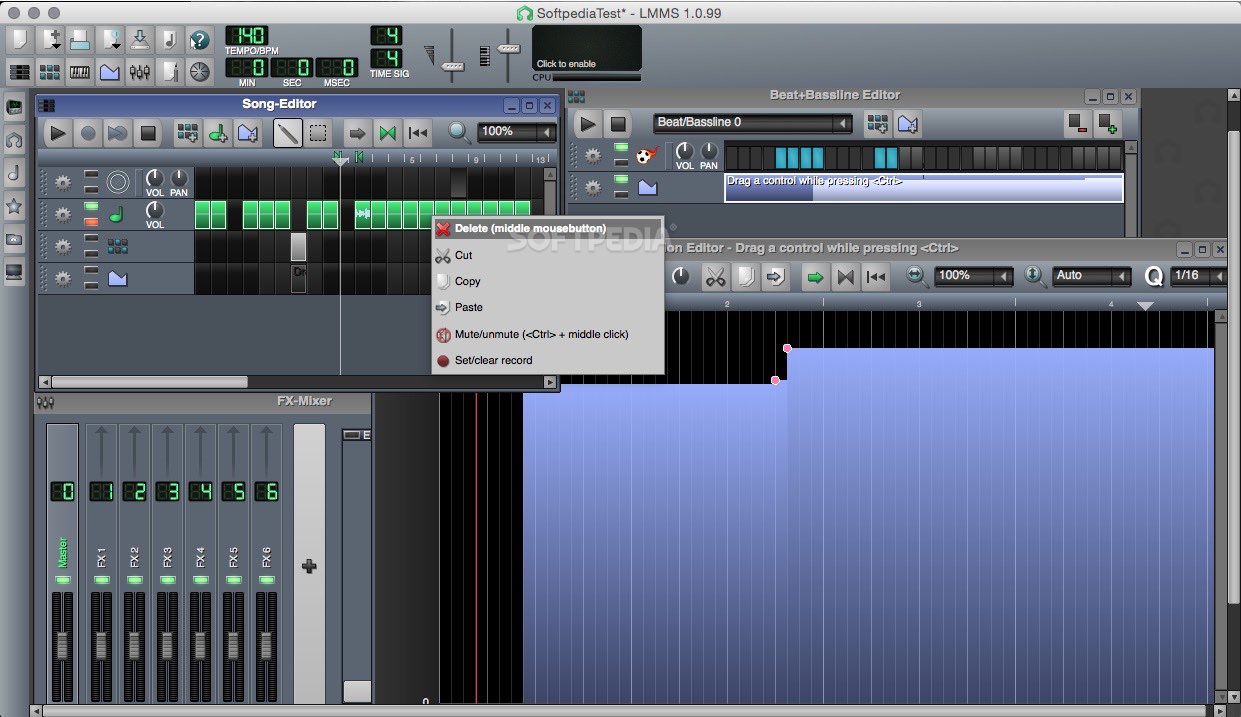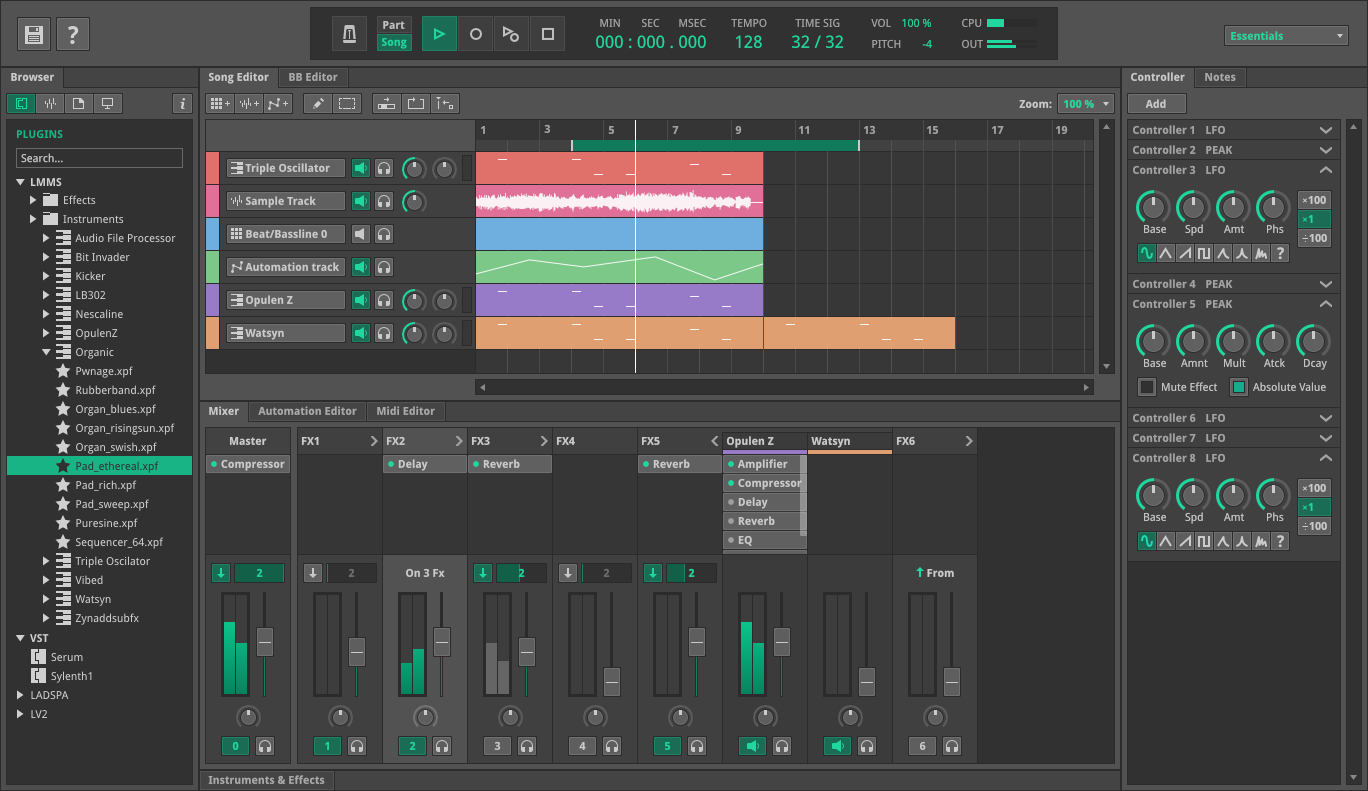

The only downside is that it bugs you for a donation every time you open the DAW. And it even comes with a mini-view of the mixer that can be viewed while the sequencer is open. Last is the mixer, and it does have a bit more features than the one in LMMS, but they both have their pros and cons. But, LMMS does have some features over this one, as I mentioned with the one-click chords. For audio patterns, this includes straightforward pitch, time, and volume controls, to name most of them,Īnd to write notes in those patterns, the piano roll in SoundBridge is good and lets you change the length of a MIDI note while you draw it instead of after in LMMS. It's also directly linked to a panel that displays whatever you have selected, making it very easy to adjust an audio file or pattern. You get much more control over the tracks and each pattern. The center of this DAW is its sequencer and is better than the one in LMMS.
#LMMS TUTORIAL 2018 DOWNLOAD#
So, for example, if you downloaded the 32-bit version of SoundBridge, you'll need to download 32-bit plugins. Just make sure to download your plugins in the same bit version as the DAW for them to work.
#LMMS TUTORIAL 2018 MAC#
This one is available on Windows and Mac in both 32 and 64-bit.

This DAW started as a Limit when it was crowdfunded, but it has evolved since then. But, you can always use Audacity to record that and then import the audio files into LMMS.Īt number two, we have SoundBridge. The one drawback I found to suck for this DAW is that you can't record audio. Even though it looks dead-simple, it does include the ability to make a send track (or mix bus) just like every other DAW on this list.

The mixer does have the same simplicity, but it does come with the basics. It's pretty clean and easy to use and has a great feature that lets you write any chord based on any scale with one click. This is what the piano roll (or MIDI editor) looks like in LMMS. The sequencer (or song arrangement window) isn't too bad in LMMS, but it is fundamental and doesn't offer much freedom, but it still gets the job done and makes it easy to manage your samples and patterns. There's even a computer keyboard to MIDI, which means you can play virtual instruments with your computer keyboard as if it was a piano. And it's even open-source, meaning it has been developed by many people - which could include you too if you wanted to contribute. It doesn't use much CPU either but, it is a very basic Digital Audio Workstation. Its availability on Windows, Mac, and Linux makes music production accessible to anyone with a computer. This is a great choice, regardless of the operating system you use. Essentially, it's a host for plugins you download, such as virtual instruments and audio effects. Just in case you don't know what a DAW is, it's short for Digital Audio Workstation, as music making software. They are all 100% Free, no strings attached.
#LMMS TUTORIAL 2018 FREE#
And don't worry, none of these are free trails or restricted. Then, I'll show you what the sequencer, piano roll, and mixer look like with a quick overview of their features. In the future you can ask questions about how you want to change things up.In this article, each DAW will have a section for key features and minimum computer requirements. Your job is to figure out what works for you. Some people use whatever presets they have, some people spend hours programming synthesizers. Some people start with a rhythm, some people start with a bass groove, some people start with a chord progression, and some people start with a melody. Some people will start by writing a score, some people will work with the piano roll, some people will record MIDI live part-by-part, some people will record real instruments. One of the problems here is that from this point, everyone is different in how they make music. You don’t need to find the best soundfonts for dungeon synth-dungeon synth, specifically, often sounds like people just grabbed random soundfonts or used existing presets, so getting “good” soundfonts kind of goes against the whole dungeon synth vibe. You probably want to download some soundfonts. In the meantime, you can use your computer keyboard to play notes. Just get some basic 49-key keyboard with USB that you can plug into your computer. Inputs-you probably want a MIDI keyboard at some point. I believe LMMS comes with a decent selection of open-source instruments. There are a zillion VSTs out there so you can always switch later. Recommended VSTs/plugins-just start playing with the plugins you have. If you don’t like a tutorial, watch a different one. Don’t worry so much about tutorial recommendations. Tutorials: Just do a search for “LMMS tutorial” and I’m sure you’ll find plenty. I don’t use LMMS, but I’ll give you some information, as music production is mostly the same even if you use a different DAW.


 0 kommentar(er)
0 kommentar(er)
